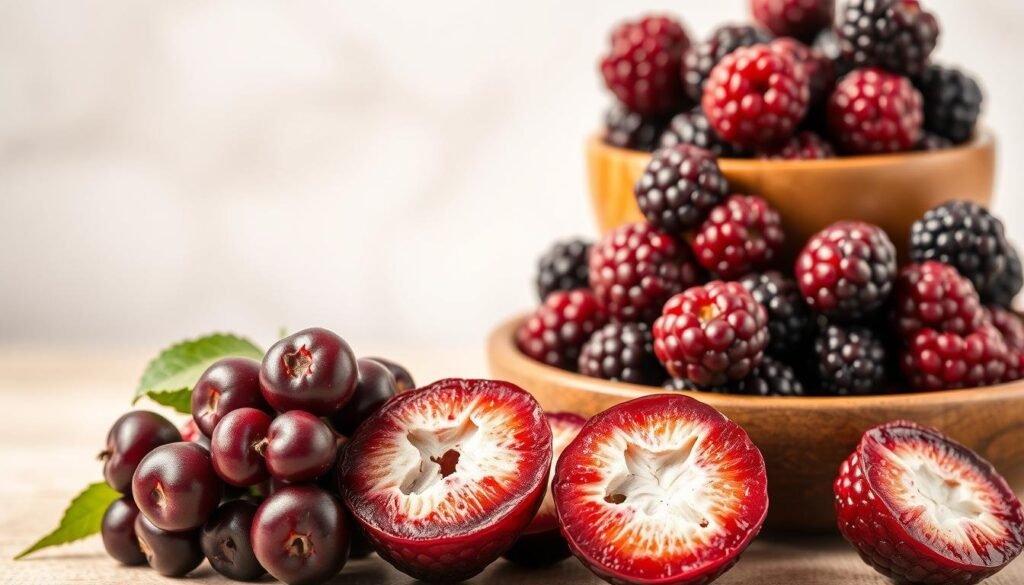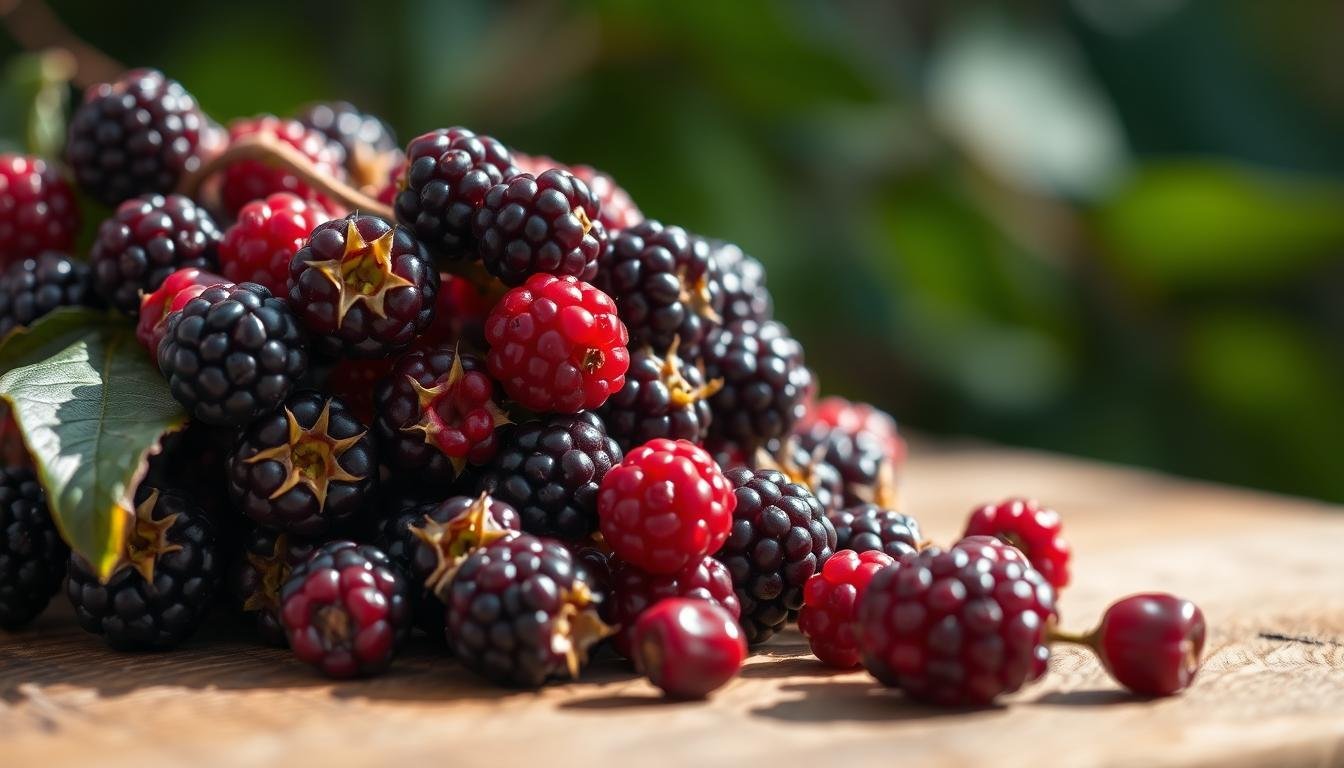Eat the Berries from a Mulberry Tree: If you’re curious about edible mulberries and their benefits, you’re not alone. Many people are drawn to the allure of mulberry trees. They have luscious mulberry tree berries and a rich history.
As you explore the world of mulberries, you’ll discover their unique characteristics. You’ll learn about their nutritional value and various uses in cooking and beyond. This article will guide you through identifying mulberry trees, understanding their benefits, and exploring ways to add them to your diet.
Contents
- 1 What Are Mulberries?
- 2 Can You Eat the Berries from a Mulberry Tree?
- 3 Identifying Edible Mulberries
- 4 Nutritional Benefits of Mulberries
- 5 How to Harvest and Prepare Mulberries
- 6 Culinary Uses for Mulberries
- 7 Conclusion: Eat the Berries from a Mulberry Tree
- 8 FAQ
- 8.1 Are mulberries safe to eat?
- 8.2 What are the different types of mulberries?
- 8.3 How do I identify edible mulberries?
- 8.4 What are the nutritional benefits of mulberries?
- 8.5 How do I harvest and store mulberries?
- 8.6 Can I use mulberries in cooking and baking?
- 8.7 Are there any potential allergies or risks associated with eating mulberries?
- 8.8 How do I clean mulberries?
What Are Mulberries?
When you delve into the world of berries, you’ll find mulberries. They have a long history. Mulberries grow on different types of mulberry trees. These trees are grown for their berries, which taste great and are full of nutrients.
There are mainly three types of mulberry trees: white, red, and black. White mulberries are sweet and used for silkworms. Red mulberries come from North America and taste tart. Black mulberries are deep purple and sweet-tart.
Each mulberry type has its own traits and uses. Knowing these differences helps you value mulberries’ variety. It also guides you when deciding to grow or eat them.
Can You Eat the Berries from a Mulberry Tree?
Wondering if you can eat mulberry berries? Yes, but be careful. Mulberries are full of good stuff like antioxidants, vitamins, and minerals. They’re great for your health.
It’s key to know the type of mulberry tree you have. There are white, black, and red mulberries, all safe to eat. But, some might get allergic reactions or stomach problems from eating them.
To safely enjoy edible mulberries, wash them well first. You can eat them raw, use them in baking, or dry them for later. Here’s a quick guide on how to eat mulberries safely and healthily.
| Preparation Method | Safety Precaution | Nutritional Benefit |
|---|---|---|
| Eating fresh | Wash thoroughly | High in antioxidants |
| Drying | Dry properly to avoid mold | Rich in fiber |
| Baking | Ensure proper cooking temperature | Good source of vitamins |
Knowing the risks and taking steps to avoid them lets you enjoy mulberry consumption. Whether raw, dried, or baked, mulberries add flavor and health to your meals.
Identifying Edible Mulberries
To safely enjoy mulberries, you need to know how to tell them apart from lookalikes. Mulberries grow on mulberry trees, found in many parts of the world. They are dark purple when ripe, but can also be white or red.
Mulberries have unique features to help you spot them. They are formed from many ovaries of one flower, making them aggregate fruits. Each fruit is 1-2 inches long and tastes sweet with a hint of tartness. When ripe, they are soft and can easily stain clothes and surfaces.
Distinguishing Mulberries from Lookalikes
Identifying mulberries can be tricky because they look like other fruits. Blackberries and raspberries are often mistaken for mulberries. But, there are clear differences. Mulberries have no solid core and are very fragile.
| Fruit Characteristics | Mulberries | Blackberries/Raspberries |
|---|---|---|
| Core | No solid core | Solid core |
| Fragility | Fragile skin | More robust |
| Taste | Sweet, slightly tart | Tart, can be sweet |
Knowing these differences helps you confidently pick out edible mulberries. This way, you can enjoy them without any confusion with other fruits.
Nutritional Benefits of Mulberries
Mulberries are not only tasty but also full of nutrients. You can snack on them or add them to different dishes. This way, you get to enjoy their health benefits.
Mulberries are rich in vitamins C and K. They also have a lot of vitamin E, potassium, and iron. These nutrients are good for your health and well-being.
Antioxidant Properties of Mulberries
Mulberries are known for their high antioxidant content. Antioxidants protect the body from free radicals. Free radicals can damage cells and lead to diseases.
The antioxidants in mulberries help reduce inflammation and improve heart health. They are also thought to help with aging.
| Nutrient | Amount per 100g | % Daily Value |
|---|---|---|
| Vitamin C | 36.4 mg | 60% |
| Vitamin K | 7.8 mcg | 10% |
| Potassium | 194 mg | 6% |
Eating mulberries can give you these important nutrients. They help keep you healthy. You can eat them fresh, dried, or in many recipes.

Mulberries offer more than just vitamins and minerals. They are also high in dietary fiber. This fiber is good for your digestive system.
How to Harvest and Prepare Mulberries
To enjoy your mulberry tree’s fruit, you need to know when and how to pick it. Mulberries are ready in late spring or early summer. The exact time depends on the type and where you live.
Picking mulberries is a bit tricky because they’re soft and stain easily. You can pick them by hand or shake the branches over a container to catch the ripe ones.
After picking, wash the mulberries to get rid of dirt. Rinse them with cold water and dry them with a cloth or paper towels.
To keep mulberries fresh, put them in a covered container in the fridge. They stay good for a few days. For longer storage, freeze them. First, freeze them on a baking sheet, then put them in airtight containers or bags.
Preparing mulberries is easy. Just rinse and serve them. You can also use them in many recipes, like jams, baked goods, and salads.
Culinary Uses for Mulberries
Mulberries are great for many dishes, from jams to salads. They add flavor and nutrition to your cooking. They’re a fantastic addition to your kitchen.
Mulberries in Desserts and Savory Dishes
Mulberries are tasty and versatile. They’re perfect for pies, tarts, and crisps. They also work well in salads and sauces, adding a unique flavor.
Here are some ideas for using mulberries in your cooking and baking:
- Add fresh mulberries to your favorite yogurt or oatmeal for added flavor and nutrition.
- Use mulberries to make homemade jam or preserves to enjoy throughout the year.
- Incorporate mulberries into your baked goods, such as muffins, cakes, and scones.
- Add mulberries to salads for a sweet and tangy twist.
| Culinary Use | Description | Benefits |
|---|---|---|
| Mulberry Jam | Homemade jam made with fresh mulberries | Rich in antioxidants and flavor |
| Mulberry Salad | Mix of fresh mulberries, greens, and nuts | High in fiber and vitamins |
| Mulberry Muffins | Baked goods made with fresh or dried mulberries | Delicious and nutritious breakfast option |
Mulberries are also great for sauces and syrups. They bring a unique taste and health benefits to your dishes. They’re perfect for experimenting in the kitchen.
Adding mulberries to your meals can make them more exciting. They’re perfect for both sweet and savory dishes. Mulberries are a great choice for any meal.
Conclusion: Eat the Berries from a Mulberry Tree
You now know that mulberries are not only edible but also packed with nutrients. They are versatile in their uses. Enjoying mulberries can be a delightful experience, from snacking on them fresh to incorporating them into various recipes.
As you’ve learned, mulberries offer numerous health benefits. They make a great addition to your diet. Whether you’re looking to enhance your culinary creations or simply enjoy a nutritious snack, mulberries are an excellent choice.
In conclusion, mulberries are a fruit worth trying. With their rich nutritional profile and culinary flexibility, you can explore different ways to enjoy mulberries. This way, you can make the most of their benefits.
See Also: Can You Eat Garlic Straight from the Garden?
FAQ
Are mulberries safe to eat?
Yes, mulberries are safe to eat. They are full of nutrients and can be enjoyed raw or in many recipes.
What are the different types of mulberries?
There are three main types of mulberries: white, red, and black. Each type has its own look, origin, and how it grows.
How do I identify edible mulberries?
To spot edible mulberries, look at their shape, color, and feel. It’s key to tell them apart from poisonous fruits that look similar.
What are the nutritional benefits of mulberries?
Mulberries are packed with vitamins, minerals, and antioxidants. They’re good for your health, helping to fight inflammation and boost heart health.
How do I harvest and store mulberries?
Mulberries are ready when they’re ripe and fall off the tree. Clean and dry them gently, then keep them in the fridge or freezer to stay fresh.
Can I use mulberries in cooking and baking?
Yes, mulberries are great in sweet and savory dishes. They add sweetness and flavor to desserts, jams, salads, and sauces.
Are there any potential allergies or risks associated with eating mulberries?
While mulberries are usually safe, some might be allergic to them. Make sure to correctly identify the berries to avoid poisonous lookalikes.
How do I clean mulberries?
To clean mulberries, rinse them with cold water. Then, dry them with a cloth or paper towels to get rid of extra moisture.

Hello, I am Bellamy George, a certified nutritionist and food safety specialist from Springfield, IL. With a degree in Food Science, I share research-backed insights on edible foods, seeds, and seafood for safe, informed eating.

